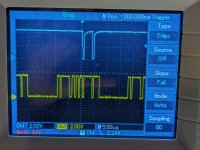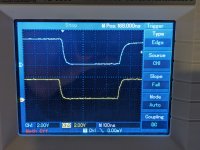daver2
10k Member
Looking good so far.
I am guessing the 1 and 2 on the left-hand side indicate the zero reference for channel 1 and channel 2 respectively.
I am also guessing that the blue arrow on the right-hand side is the trigger level. At the moment it is at the bottom. It needs to be halfway between the top and bottom of the indicated signal.
I also notice that the coupling is AC. This needs to be DC for both channels!
See if you can make those changes.
Dave
I am guessing the 1 and 2 on the left-hand side indicate the zero reference for channel 1 and channel 2 respectively.
I am also guessing that the blue arrow on the right-hand side is the trigger level. At the moment it is at the bottom. It needs to be halfway between the top and bottom of the indicated signal.
I also notice that the coupling is AC. This needs to be DC for both channels!
See if you can make those changes.
Dave
Last edited:


